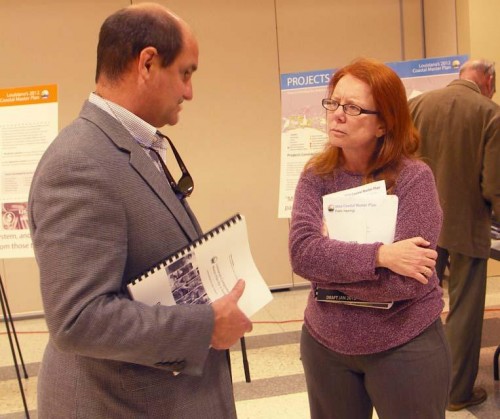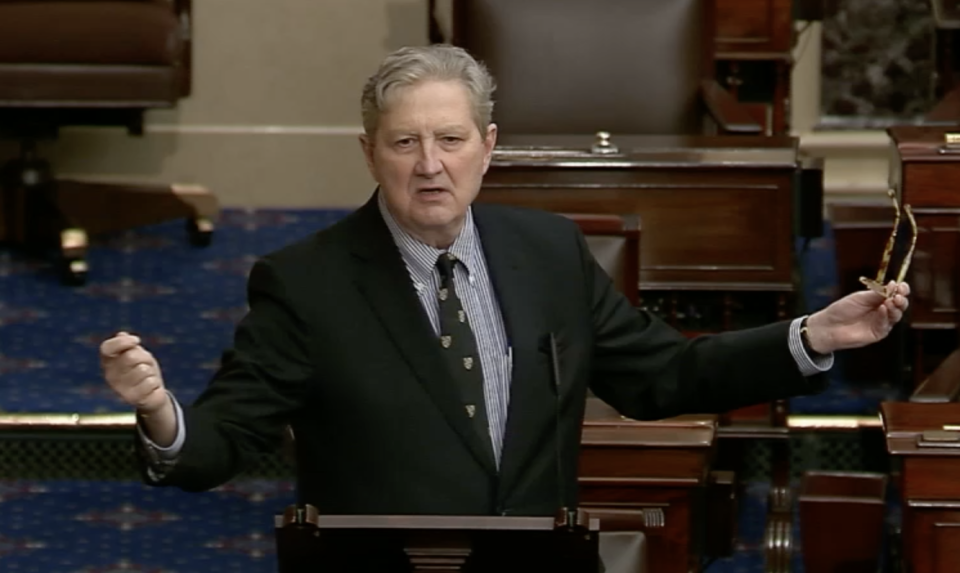Stopping the rush to war against Iran
February 1, 2012Hitting its stride
February 3, 2012Twelve easels displayed high quality charts and maps, computerized models demonstrated land loss, lapel stickers identified the wearer as being “committed to our coast,” and thousands of available bound booklets and glossy brochures proclaimed a common message n that coastal restoration is important to Louisiana.
The open house-style presentation at the second of three public forums, hosted by the Coastal Protection and Restoration Authority of Louisiana, was a marketing effort to promote Louisiana’s 170-page Comprehensive Master Plan for a Sustainable Coast.
The program and the plan both failed to impress many locals who live and work on the frontline of coastal concerns every day.
“They are telling us what [coastal Terrebonne and Lafourche parishes] will look like in 50 years?” Troy Voisin of Dulac asked as he pointed toward a map projecting land loss. “That’s what it is like right now. They aren’t showing us anything we don’t already know or how they are going to fix it.”
“The idea of this meeting is an open house where people can get information about the process we used to develop the plan, the science that went into the plan and all the background information they would need,” Coastal Protection and Restoration Authority Master Plan Chief of Planning Kirk Rhinehart said during the event last Tuesday at the Houma-Terrebonne Civic Center.
“This is to get information out to the stakeholders, let them know what they can expect in terms of risk reduction, flooding, restoration projects in the area for their communities [and] businesses,” the program leader explained.
More than 400 projects were reviewed by the CPRAL and reduced down to 145 projects in the final plan with a budget of $50 billion over 50-years.
According to Rhinehart, this is the first time that the state has stepped beyond the concept of projects coast-wide and identified projects that would sustain the landscape and provide long-term risk reduction.
Among Tri-parish region projects alone is an identified need to complete Morganza to the Gulf and an increase in the Larose to Golden Meadow system for 100-year protection.
Master plan restoration proposals include restoring more than 5,000 acres of dunes, beach and back area marsh on Timbalier barrier islands to be implemented between 2012 and 2031. During that same timeframe planners also included intentions for increasing flow of the Atchafalaya River with a sediment diversion into Terrebonne Parish.
The plan calls for freshwater enhancement into central Terrebonne Parish along with hydrologic restoration of the Houma Navigational Canal, marsh creation along the Intracoastal Waterway, elevation enhancement by one foot in Houma, oyster barrier reef restoration in Vermilion Bay and ridge restoration in Terrebonne Parish.
“I’m happy that they have included restoration of the barrier islands and the Morganza levee,” said Terrebonne Parish President Michel Claudet. “However, there is no marsh creation in any portion of the parish other than the extreme western, uninhabited part. The areas that are the most critical and have been deteriorating the most are completely without any assistance. I also want to point out that it looks like the funding of the Morganza levees and the barrier islands will still be dependent upon federal funding, and based upon what I can see, if there is any funding that comes in from the Restore Act and other programs it will be used 100 percent in the New Orleans area.”
“I think it is great that they want to come out and meet with the people and all, but what I want to see is how our land is disappearing on the Internet,” Voisin said with admitted sarcasm. “We are the people living this. Today, we come here and see pictures of it disappearing. No, it’s gone now.”
According to the master plan, an investment of $25 billion to increase protection levels could prevent up to $220 billion in direct asset damage to individuals and communities within 50 years.
Benefits of the plan are listed as protecting species that inhabit the coast, enhancing the ecosystem associated with vegetation and open water, controlling carbon and building nitrogen levels in the coastal landscape, and enhancing nature-based tourism.
Not every Tri-parish resident was as hard on the Louisiana Coastal Master Plan as others. Oscar Pena is a program manager with Shaw Coastal and has been working closely with the Terrebonne Levee and Conservation District on construction of the Houma Navigational Canal floodgate complex, which is on schedule for completion in March 2013.
The HNC project, designed by Shaw Coastal and built by Gulf Island Fabricators and Bollinger Shipyards, represents one piece of the TLCD hurricane protection plan and consists of three levee reaches and four structures that have been financed primarily by Terrebonne Parish residents.
Explaining it as being part of an unofficial coastal plan, Pena, who said he did not attend the coastal master plan open house, noted that the HNC floodgate, with a more than $48 million price tag, is one part of a network of structures, including the Bush Canal, Placid Canal and Bayou Grand Caillou floodgates that have been built by local sources separate from an official state master plan.
“It’s a good deal,” Pena said of the state plan. “I believe what we have done will dovetail into the master plan issue. Morganza to the Gulf is part of that and everything we are building is along the Morganza-to-the-Gulf alignment.”
“The Master Plan has a lot of good things in it,” state Rep. Gordon Dove (R-Houma) said. “I’m glad to see redevelopment of the barrier islands as a priority. There are things I’d like to see added like land bridges and marsh development in eastern Terrebonne Parish, and remember, we got a jump on the master plan [locally].”
“Morganza-to-the-Gulf protection will provide 100-year protection to Houma,” Rhinehart said of what he viewed as a highlight of the master plan. “We’ve also got an increase in the Larose to Golden Meadow system for 50 years. All the barriers are in this plan as well as bringing water off the Atchafalaya River into Terrebonne Parish and increasing fresh water in Bayou Lafourche.”
Rhinehart admitted that funding for any of the listed projects is not guaranteed, but said CPRAL is taking what it views as a realistic projection of costs over the course of 50 years. “We decided to formulate the plan so we could look at projects and go to D.C. to get funding so we could build high performing projects.”
In addition to placing hopes on federal funding from Congress, Rhinehart said that his agency intends to look into Clean Water Act dollars, Gulf of Mexico Energy Security Act funds and additional funding sources to foot the bill on its list of proposals.
“The idea here is to get everybody on the same page and pulling in the same direction,” the planning chief said. “Then we will be more successful in getting funding.”
Dove, who is chairman of the state House of Representatives Natural Resources Committee, said that CPRAL public meeting was intended to be session during which planners could receive public reaction to its preliminary considerations.
“We will be meeting with [the CPRAL] and going over all this,” Dove said to the role his Natural Resources Committee will play in further developments of the Coastal Master Plan.
During a telephone interview, Rep. Bill Cassidy (R-Baton Rouge) expressed concern regarding coastal protection and restoration becoming lost in government bureaucracy. Neither does he want it to become a matter of big promises with no concrete financial backing.
“Whatever is decided upon will not be able to be implemented unless there is money to pay for it,” Cassidy said. “What I’m about is letting our leaders know the national importance of Louisiana’s coastal restoration so that whatever that final plan is there is money to pay for it.”
The congressman called it reasonable to think in advance how to make use of funds if money is provided, but warned against making commitments without certainty on completing a task. “We as a nation need to make sure the money is there,” he said.
Cassidy expressed that federal revenue collected from oil and gas drilling off the coast of Louisiana could be cannibalized into projects not associated with Louisiana. In particular he contends that those funds could be used to help with coastal restoration. “We cannot sustain outer continental shelf drilling without the Louisiana coastline,” he said. “So let’s not kill the goose that lays the golden royalties.”
Louisiana is in line to benefit from 37.5 percent of deepwater oil and gas extraction royalties in 2017. According to a constitutional amendment passed by voters in 2006, all revenue from offshore drilling is to be used for coastal restoration and specifically restricts those funds from being used in general government operations.
Last week, Cassidy sent a letter to House of Representatives Majority Leader Eric Canter in which he stated the importance of coastal restoration in Louisiana and how it impacts the nation as a whole, and requested passage of a Restore Act which would insure at least 80 percent of fines paid by BP from the 2010 Deepwater Horizon oil spill be returned to Louisiana for coastal restoration.
“We all know that Terrebonne Parish is ground zero for land loss in the state and the United States,” Claudet said. “This [coastal master plan] does not speak to that.”
“It is hard to get people to answer your questions,” Voisin said regarding state employees working the public meeting.
Fletcher Technical Community College adjunct geology instructor James Sothern said that government officials do not understand what is taking place on coastal Louisiana and in turn locals are skeptical of government-backed programs.
“They don’t trust the politicians,” Sothern said to explain the negative reception given to the public forum. “They are burned out. I am encouraged by what I see here, but there is a lot more involved.”
Locals that expressed disappointment in the Louisiana Coastal Master Plan said they expected to see specific programs ready for implementation.
Voisin was among the number that said they already know about the problem. He and his neighbors want to know when they can or if they will see specifically something being done about it.
“Everyone won’t be pleased with the first read of this plan,” Dove said. “That’s why they call it a preliminary plan.”
South Central Planning and Development Commission CEO Kevin Belanger and Terrebonne School Board Member Brenda Babin discuss the implications of the Louisiana Coastal Master Plan as it is presented in open house forum at the Houma-Terrebonne Civic Center. MIKE NIXON












